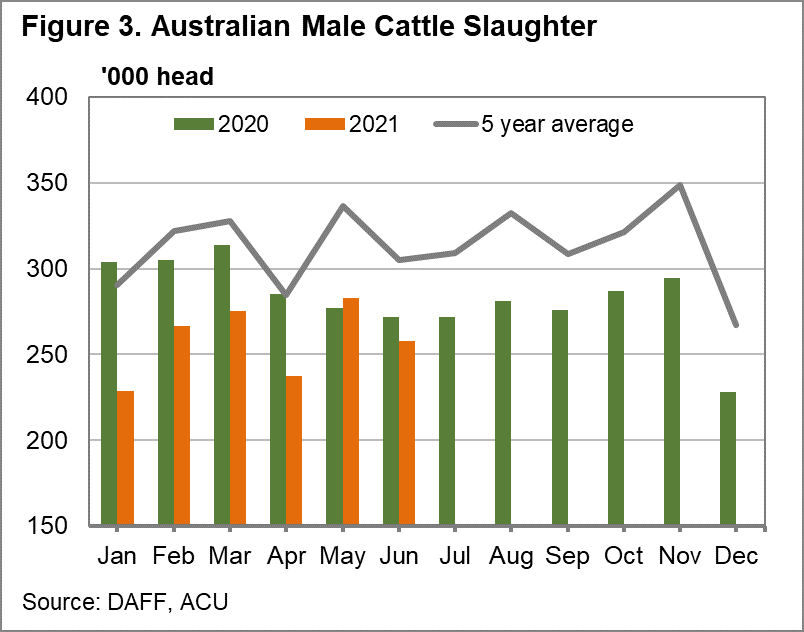The Australian Bureau of Statistic’s (ABS) released it’s second-quarter cattle slaughter numbers, showing extreme tight supply in the first half of the year. While the Eastern Young Cattle Indicator (EYCI) hit yet another record this week, and it looks to keep on breaking more, we are going to have to see another reduction in slaughter forecast before the end of the year.
On Tuesday Mecardo looked at the Female Slaughter Rate (FSR), but it’s total and male slaughter which gives an idea of how supply of better value beef is tracking. Total cattle slaughter for the second quarter was down 20.6% on the same quarter in 2020, but in line with seasonality, up 6% on the first quarter of 2021.
The first half of the year has marked the lowest January to June slaughter since way back in 1984, which was the low following the late 70’s price collapse. There were 24% fewer cattle processed in the first half of 2021, than in 2020. This is a huge reduction, and this sort of fall hasn’t been seen in any records going back to 1972.
MLA’s Cattle Industry projections were only updated in July, but are already looking a bit strong on the cattle slaughter front. With the cattle slaughter forecast pegged at 6.3 million head, it leaves 3.39 million head left for the second half. With just 2.9 million head processed in the first half, it would require a significant lift.
If we take into account the steady slaughter rates for July and August, it means rates will have to pick up even more in the coming four months to hit the target. Figure 1 shows that to hit the 6.3 million head, October to December slaughter will have to be 12% higher than last year.
Female slaughter fluctuates wildly with season, but male slaughter tells us more about the size of the herd and how many cattle will be available for the year. First half male cattle slaughter was down 12%, with most of the fall coming in the first quarter. Figure 2 shows that male cattle slaughter is generally stronger in the second half, so we might see lifting supply in the spring at least.
What does it mean?
Male cattle slaughter might just be able to hit the levels of last year, but the herd rebuild will see total slaughter fall behind. Even if total cattle slaughter matches last year, it will only just manage to get past 6 million head. It was 1985 when there were less than 6 million head of cattle were slaughtered. Continued tight supply is to be expected, and with it, strong prices.
Have any questions or comments?
Key Points
- ABS second-quarter cattle slaughter was up on the first quarter but way down on 2020.
- First half male cattle slaughter was down by 12%, reflecting a heavy fall in the herd
- Cattle slaughter will struggle to reach 6 million head, the lowest levels since 1985.
Click on figure to expand
Click on figure to expand
Data sources: ABS, MLA, Mecardo



